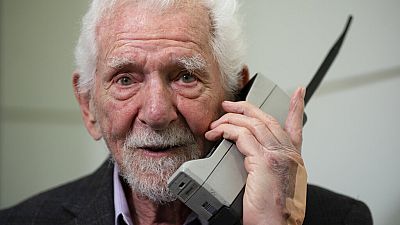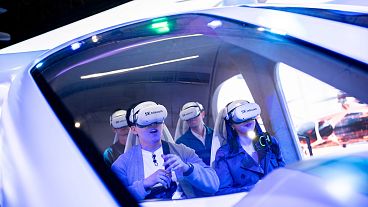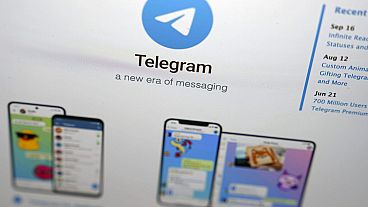6G is expected to start rolling out in around 2030, ushering in a new world of digital interconnectedness like we’ve never seen before.
5G is one of the main talking points at Mobile World Congress (MWC) this year, with telecoms giants from around the world all showing off their capabilities and network speeds with flash displays and armies of networking employees.
But while 5G is the now and the near-future, 6G - the sixth generation of the mobile network - has also been on the agenda.
There’s still an air of mystery around 6G. Nobody at MWC seems to know exactly how it will work or what it will make possible, but at the same time many are promising a new world of digital interconnectedness like we’ve never seen before.
So, how far away are we from a world of holographic communications, 3D localisation, and autonomous vehicles in the air and on the ground?
What is 6G and why is Mobile World Congress talking about it already?
6G is the next generation of mobile communication - and if it delivers on its promise, it will make 5G feel like an old dial-up Internet connection in comparison.
While it isn’t known yet how it will be achieved, experts expect it will be here by around the year 2030. According to Nicolas Kourtellis, Principal Research Scientist and Co-Director at Telefónica Research, it will boost network capacity by around 500 times.
He was talking on stage at MWC in Barcelona, at a debate alongside other experts who are at the forefront of 6G research. According to Kourtellis, 6G will deliver a huge increase in the data that can be transferred, and in the speeds it happens - all with “virtually zero latency”.
And according to the experts, it is going to be needed, and soon, due to the sheer scale of connected devices and data zipping around. Yue Wang, head of 6G research at Samsung Research UK, explained that “mobile GPU capability is not keeping pace with new service requirements,” and there will be some 500 billion connected machines by 2030 - which is 59 times the global population.
We are seeing annual growth of mobile and Internet traffic of 55 per cent, she added, as the world becomes ever more connected with autonomous vehicles and the growth of VR and AR. Not only will 5G technology struggle to deliver on that scale, it would also be environmentally unsustainable.
A recent scientific paper from the University of Massachusetts found that training a single AI model can emit as much carbon dioxide as five cars in their lifetime, so a key part of the research into 6G is around making it much greener than 5G, on top of being faster and more powerful.
Convergence of terrestrial and extraterrestrial connection
Another key part of the current research is on how 6G will even be made possible. And the answer to that, according to Xavier Lobao, is with space.
Lobao heads up the Future Telecom Projects Division at the European Space Agency, and he told Euronews Next there will be a convergence of terrestrial and non terrestrial networks to increase connectivity.
His team is currently working on a proposal to set up a “6G in orbit laboratory,” which he said has caused some confusion.
“When I first made the proposal, people were shocked because they said 6G is not defined. How are you going to launch a satellite if we don't know what it will be? And my answer to that is that we don't know,” he said.
His team wants to contribute to the definition of 6G, he adds, and they are building an experimental satellite to test in a realistic way how it can interact and compare with terrestrial networks.
The need for satellite connectivity is driven by the need for coverage everywhere - not just where population centres are.
“Just to give an example, when we are thinking about the autonomous vehicle, cars just don't go through highways, they go through narrow roads, they go through mountains, valleys and so on,” he said.
“When we are thinking about an autonomous car in the future, there will have to be very good connectivity everywhere so that there is a reliable way of operating the vehicle in a safe and secure way”.
6G will bring ‘significant security issues’
Creating an ever-more interconnected world brings with it new security risks.
Alex Choi, the head of T-Labs at Deutsche Telekom, told Euronews Next it was a little early to talk about the exact use cases of 6G, but was clear it “should enable true digital inclusion and be optimised for energy efficiency and for unprecedented levels of privacy, reliability and security”.
T-Labs are currently focussing research on satellite the convergence of the terrestrial and satellite network, he explained, as well as energy efficiency.
But from the beginning, for Choi, security has to be paramount, because “6G is going to bring even more significant security issues”.
What we are talking about in the 6G era, he said, “is everything connected” - our entire daily lives and the running of businesses around the world are going to rely on connectivity services.
An attack on these systems would cause havoc, so “you have to be really 100 per cent, or 1,000 per cent certain about security,” he said. With recent improvements in AI and machine learning algorithms, predicting these kinds of threats are becoming more feasible than before, Choi added.
While a lot is still not clear about a 6G connected world, what is clear is that if the experts at MWC are correct, 2030 is going to look very different to 2023.



